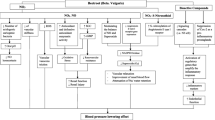Abstract
Objective
To explore the regulative efficacy of Pu’er tea (普洱茶) extract on metabolic syndrome.
Methods
Ninety patients with metabolic syndrome were randomly divided into two groups, the intervention group administered with Pu’er tea extract, and the placebo group with placebo capsules. After 3 months’ treatment, body mass index, waist hip ratio, blood lipids, blood sugar, immune and inflammatory index, and oxidation index of the patients with metabolic syndrome were tested and analyzed.
Results
In the intervention group, the body mass index, waist-hip ratio, fasting and 2 h postprandial blood glucose, serum total cholesterol, triglycerides, low density lipoprotein and apolipoprotein B-100 all decreased in the patients with metabolic syndrome, and also the high-density lipoprotein level increased and apolipoprotein A-1 showed the tendency to increase. Serum C-reactive protein, tumor necrosis factor-α, and interleukin-6 were decreased in the intervention group. Interleukin-10 level was increased, MDA was decreased and superoxide dismutase was increased. Compared with before treatment and the placebo group, there were significant differences (P<0.05, P<0.01).
Conclusions
Pu’er tea demonstrated excellent potential in improving central obesity, adjusting blood lipid, lowering blood sugar, regulating immunity and resisting oxidation. It can adjust the metabolic syndrome of different clinical phenotypes to different degrees, and is ideally fit for early prevention of metabolic syndrome.
Similar content being viewed by others
References
Wang PS, Liang MZ. Foretime and now of Pu’er tea. Tropical Agricultural Sci Technol (Chin) 2001;24(4):23–27.
Metabolic Syndrome Study Group of Diabetes Branch of Chinese Medical Association. Recommendations on the metabolic syndrome of Diabetes Branch of Chinese Medical Association. Chin J Diabetes (Chin) 2004;12:156–160.
Eckle RH, Grundy SM, Zimmet PZ. The metabolism syndrome. Lancet 2005;365:1415–1428.
Gu D, Reynolds K, Wu X, Chen J, Duan X, Reynolds RF, et al. Prevalence of the metabolism syndrome and overweight among adult in China. Lancet 2005;365:1398–1405.
Xiao YX. Recognition and therapeutic thoughts on metabolism syndrome. Chin J Basic Med Tradit Chin Med (Chin) 2007;13:538–539.
Li XJ, Liu ZL. Discussion on treatment of metabolism syndrome from spleen. Guiding J Tradit Chin Med Pharmacol (Chin) 2006;12(4): 9–10.
Yuan HB, Zhong J, Yi J, Zhao Y, Cao J. Tea extract on diet-induced obese rats lipogenic gene expression. Acta Nutrimenta Sin (Chin) 2009;31:167–171.
Jiang XF, Shao WF, Hou Y. Study on the function of preventing the hyperlipidemia lipid level and the antioxidant of the Pu’er tea. J Yunnan Agricultural Univ (Chin) 2009;24:705–711.
Zhou BX, Kong LB, Chen JX. Study on extraction of Pu’er tea polysaccharides and hypoglycemic. Chin Agricultural Sci Bull (Chin) 2009;25(15):55–59.
Wellen KE, Hotamisliglil GS. Obesity-induced inflammatory changes in adipose tissue. J Clin Invest 2003;112:1785–1788.
Cardoso-Saldaña G, Juárez-Rojas JG, Zamora-González J, Raygoza-Pérez M, Martinez-Alvarado R, Posadas-Sánchez R, et al C-reactive protein levels and their relationship with metabolic syndrome and insulin resistance in Mexican adolescents. J Pediatr Endocrinol Metab 2007;20:797–805.
Kraja AT, Province MA, Arnett D, Wagenknecht L, Tang WH, Hopkins PN, et al. Do inflammation and procoagulation biomarkers contribute to the metabolic syndrome cluster. Nutr Metab (Lond) 2007;4:28.
Ferrari R, Ceconi C, Curello S, Cargnoni A, Alfieri O, Pardini A, et al. Oxygen free radicals and myocardial damage: protective role of thiol-containing agents. Am J Med 1991;91(3C):95S–105S.
Hatori N, Sjöquist PO, Marklund SL, Pehrsson SK, Rydén L. Effects of recombinant human extracellular-superoxide dismutase type C on myocardial reperfusion injury in isolated cold-arrested rat hearts. Free Radic Biol Med 1992;13:137–142.
Lee KU. Oxidative stress markers in Korean subjects with insulin resistance syndrome. Diabetes Res Clin Pract 2001; 54(Suppl 2):S29–S33.
Yang AF, Liu MY, Wang CQ, Ding HY, Xie XL, Xu YM, et al. Metabolic syndrome patients with oxidation — index changes of platelet aggregation. J Cardiovas Pulmonary Dis (Chin) 2004;23:228–230.
Author information
Authors and Affiliations
Corresponding author
Additional information
Supported by the Major Project of Development of Biotic Resources in Yunnan Province (No. 2007YNCXB-01-01)
Rights and permissions
About this article
Cite this article
Chu, Sl., Fu, H., Yang, Jx. et al. A randomized double-blind placebo-controlled study of Pu’er tea (普洱茶) extract on the regulation of metabolic syndrome. Chin. J. Integr. Med. 17, 492–498 (2011). https://doi.org/10.1007/s11655-011-0781-4
Received:
Published:
Issue Date:
DOI: https://doi.org/10.1007/s11655-011-0781-4




